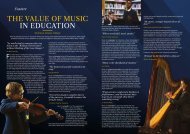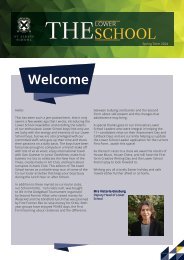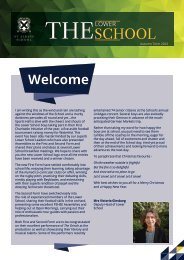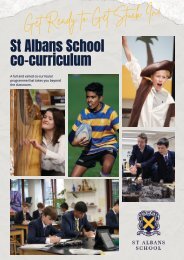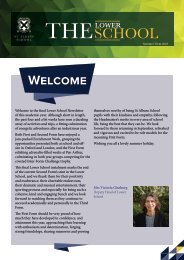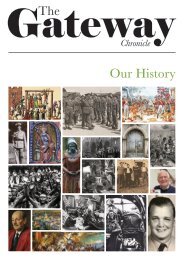Create successful ePaper yourself
Turn your PDF publications into a flip-book with our unique Google optimized e-Paper software.
17<br />
early 1990s. The sports boycott had rendered them<br />
unable to play the amounts of international sport as<br />
the other leading rugby nations and this was beginning<br />
to show when the All Blacks toured in 1992.<br />
This was their first tour to South Africa since 1976<br />
and it resulted in an All Black victory. The Springboks<br />
were booed and berated by their country not<br />
only for their poor quality of sport but due to the<br />
team’s history as an elitist white organization that<br />
was representative of everything that was wrong<br />
with South Africa. In the 1992 tour, the ANC made<br />
several demands: that the old South African flag<br />
not be flown and that the anthem, Die Stem van<br />
Suid-Afrika, not be played. These both held strong<br />
connections to the supposed glory of apartheid and<br />
focused on the triumphs of minority rule. However,<br />
the crowd of 72,000 waved the old flag and<br />
the anthem was played through the stadium’s PA<br />
system, along with racial chants and slurs from the<br />
stands. In addition, the blacks would often cheer on<br />
the opposition in defiance of white supremacy. The<br />
gaping chasm between blacks and whites was still<br />
evident and without a unifying force, the idea of<br />
Nelson Mandela’s “Rainbow Nation” was looking<br />
increasingly unlikely. It is important not to forget<br />
that going into the world cup South Africa were<br />
ranked ninth in the world so a high placed finished<br />
could help to rectify this and change attitudes to the<br />
Springboks.<br />
Another interesting dynamic is that the Springboks<br />
had one ‘token’ black player in the World Cup squad<br />
named Chester Williams. He was the first nonwhite<br />
to play for South Africa since 1984 when his<br />
uncle, Avril Williams, and Errol Tobias were members<br />
of the squad. Due to the separate sport governing<br />
bodies for blacks and whites, coloured players<br />
had not been selected to represent South Africa<br />
before the removal of apartheid in 1991. Being the<br />
third non-white to represent the Springboks carried<br />
a burden. It is undeniable that this was the beginning<br />
of a process that is continuing in South African<br />
rugby, a particular highlight being Siya Kolisi<br />
becoming the first black Captain, but by no means<br />
was this perfect solution. Chester, being the only<br />
player of colour on the team, resulted in him being<br />
paraded as a victory by the rugby board instead of<br />
the start of things to come. However, this also led<br />
to Chester being viewed as a folk hero among rainbow<br />
nation supporters. He became the poster boy<br />
for the world cup with billboards being used to win<br />
around black South Africans to come out in support<br />
to Springboks. There were critics on both sides of<br />
Hidden Voices<br />
the spectrum; those who believed Chester was a glorified<br />
publicity stunt and that there should be more<br />
black players on the team and those who believed<br />
he shouldn’t have been called up in the first place.<br />
However, his popular following by black and white<br />
South Africans alike help to sow the seeds of unity<br />
that would flourish under their unbeaten campaign.<br />
The group stage got off to an excellent start with<br />
South Africa winning all three of their matches including<br />
one against world champions Australia and<br />
a 20-0 victory over Canada. Wins against Western<br />
Samoa and France in pouring rain saw them placed<br />
against New Zealand in the final. The All Blacks<br />
had also won all their games so far and the Springboks<br />
faced them, bitter from their defeat three years<br />
ago.<br />
The final took place in the Ellis Park stadium, in<br />
Johannesburg, in front of a crowd of 63,000. A<br />
myriad of new South African flags greeted the<br />
players as they walked out onto the pitch and the<br />
new national anthem was sung. Mandela had requested<br />
that all the players know the lyrics to Nkosi<br />
Sikelel’ iAfrika to help reinforce unity. 62,000 of<br />
the 63,000 in attendance were of white Afrikaans<br />
decent, the audience that traditionally supported<br />
the Springboks, but the difference this time was<br />
that those who traditionally opposed or berated the<br />
Springboks came out in support of them, watching<br />
in their millions up and down the country. The first<br />
half saw no scores added to the total and the second<br />
half left the two nations at level pegging as the<br />
clock ticked over to extra time. A penalty for each<br />
side left the scores 12-12 but in the last minute of<br />
the first half of extra time, a drop goal from Joel<br />
Stransky wrapped up the match and South Africa<br />
were crowned champions.<br />
After the final whistle had blown, Nelson Mandela<br />
walked out sporting a green and gold jersey and<br />
cap of the Captain François Pienaar. In front of<br />
crowds of adoring South Africans, he shook hands<br />
with Piennar and presented him with the William<br />
Webb Ellis trophy. The shirt that had become synonymous<br />
with racism and apartheid being worn by<br />
South Africa’s first black president was possibly the<br />
greatest public symbol of unity, one that no money<br />
could buy. The symbolic handshake showed the unanimity<br />
of the old and new South Africa and more<br />
importantly it perfectly conveyed Mandela’s desire<br />
for a rainbow nation - a nation where blacks and<br />
white do not just co-exist but care for and respect





